Disclaimer: This post may contain Amazon affiliate links. Sudachi earns a small percentage from qualifying purchases at no extra cost to you. See disclaimer for more info.
What is Chicken Udon Noodle Soup?
Chicken udon noodle soup is a delicious, soupy udon dish with chicken as the main ingredient. In Japan, you’ll find a variety of soups, ranging from simple ones flavored with traditional dashi stock and soy sauce to soups with a base of green onions and salt.
This recipe is especially for a chicken udon noodle soup called “tori nanban udon” (鶏南蛮うどん). You may associate the word “Nanban” with “chicken nanban,” a popular fried chicken dish topped with tartar sauce, but the term is also used for noodle dishes that contain green onion (or naganegi in Japanese).
Chicken Nanban udon was inspired by a more popular dish, kamo nanban soba, a noodle dish made with slices of duck meat and thick pieces of spring onion served over soba noodles in a dashi-based broth. From duck nanban soba, came chicken nanban soba. Since the noodles in soba and udon dishes are often interchangeable, Chicken Nanban udon was born.
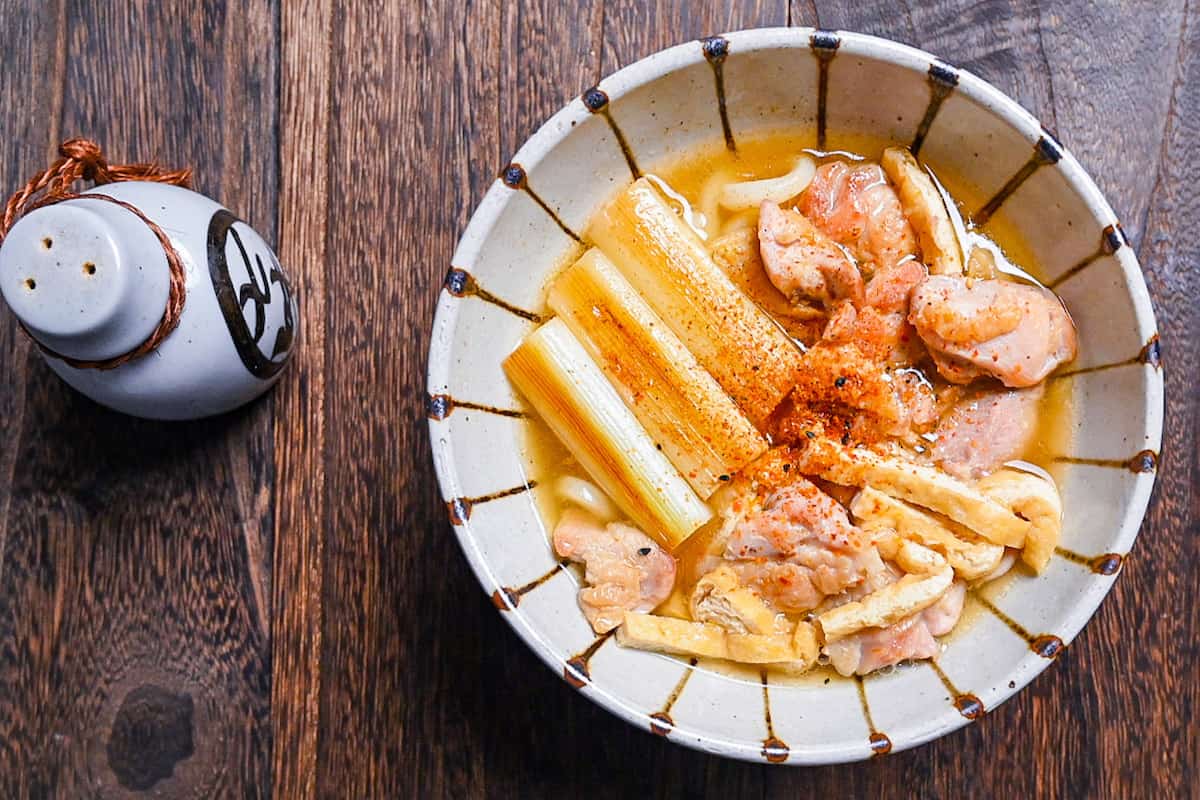

How I Developed This Recipe
For the Tori Nanban Udon recipe, I aimed to create a dish characterized by its gentle and comforting flavors, perfect for any day of the week. The goal was a dish that’s neither too salty nor greasy, but still offers a soothing taste that warms the heart.
This udon is an ideal choice when you’re in the mood for a warm, easy-to-eat noodle dish that’s both nourishing and unassuming in its delicious simplicity!
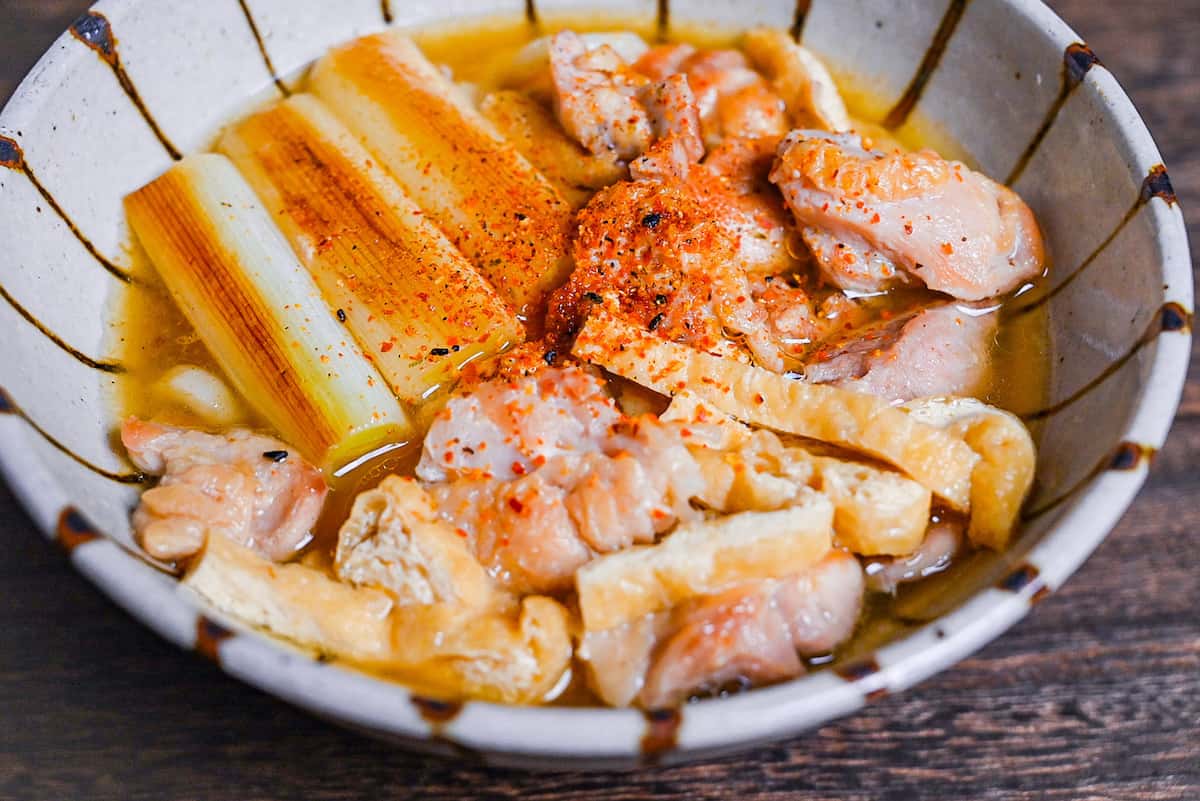
Ingredients & Substitution Ideas
- Katsuobushi (dried bonito flake) – This is used on top of dashi stock.
- Udon noodles – These thick wheat noodles have a wonderful chewy texture and are one of the most important elements of the dish. You can go for pre-boiled udon, dried udon, or frozen udon.
- Chicken thigh – Chicken thighs with the skin on are recommended if possible. Chicken breasts can be substituted if preferred.
- Aburaage (fried tofu pouches) – Foods made by frying thinly sliced tofu in oil.
- Japanese leeks – Use the white part. You can easily substitute it with regular leeks.
- Dashi stock – Awase dashi containing dried bonito flakes is recommended. If you do not make homemade dashi, you can use dashi packets or dashi granules.
- Chinese chicken soup powder – I use Youki’s organic chicken bouillon powder all the time.
- Light soy sauce – You can substitute for dark soy sauce, but in that case you will need to increase the amount just a little bit (because the usuuchi soy sauce is higher in salt) and your soup color will be darker.
- Sake – Adds umami to the soup and softens the flavor of the meat. If you can’t get it, it’s okay to omit.
- Mirin – Adds depth and sweetness to the soup. If you want to know recommended brands for mirin, check out my “20 Most Useful Condiments and Seasonings for Japanese Cooking” post.
- Salt – to balance the flavor.
- Shichimi togarashi – Optional, but adding shichimi togarashi will enhance the flavor of the soup and add a slight spicy kick, I recommend S&B’s as they are easy to find.
Curious about the exact brands and products that bring my recipes to life? Discover the brands and ingredients behind my recipes at the Sudachi Amazon Storefront. Explore my handpicked pantry essentials and find your next kitchen favorites!
Jump to Full Recipe Measurements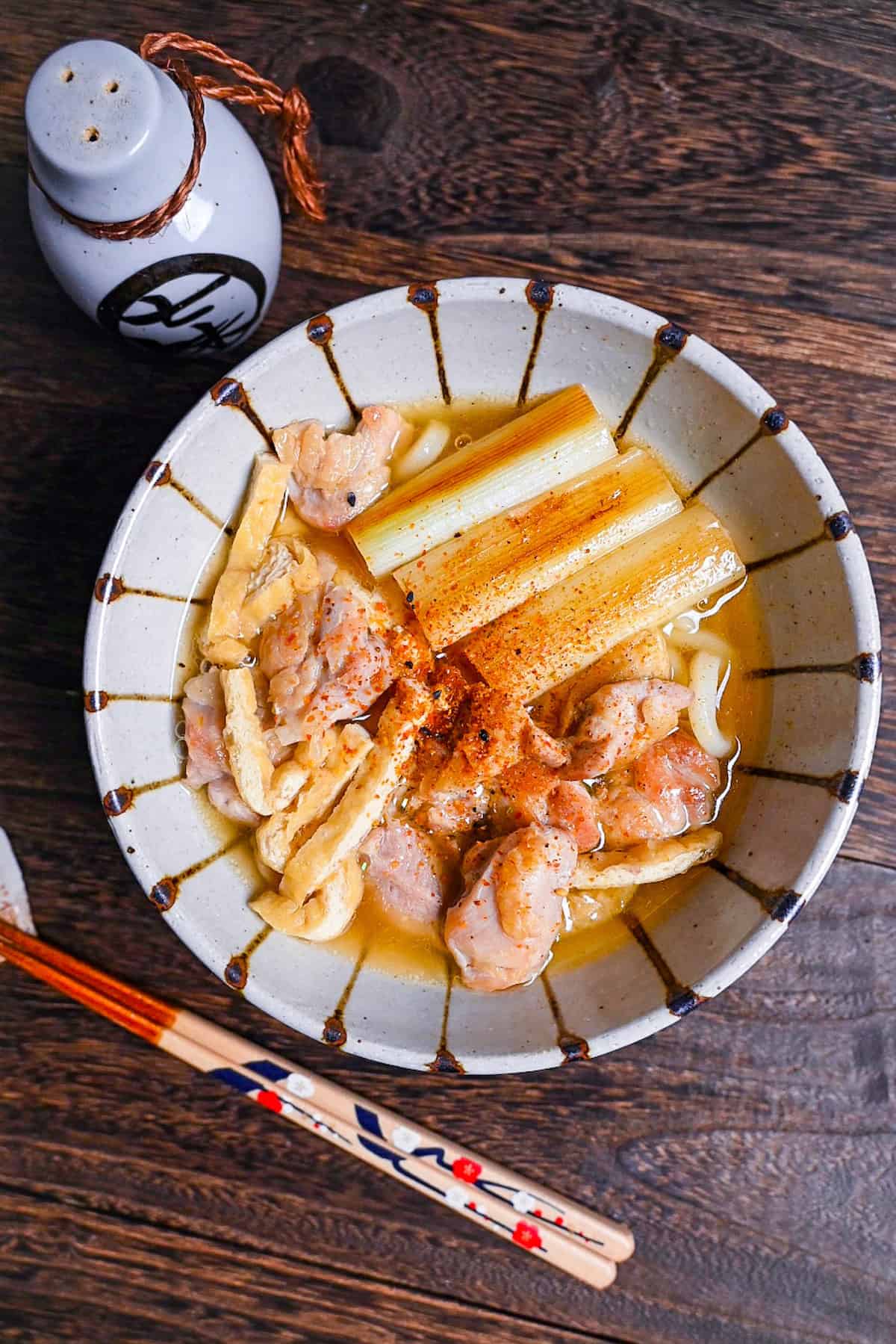
Visual Walkthrough & Tips
Here are my step-by-step instructions for how to make Chicken Udon Noodle Soup at home. For ingredient quantities and simplified instructions, scroll down for the Printable Recipe Card below.
Cut the chicken thigh into bitesize pieces.
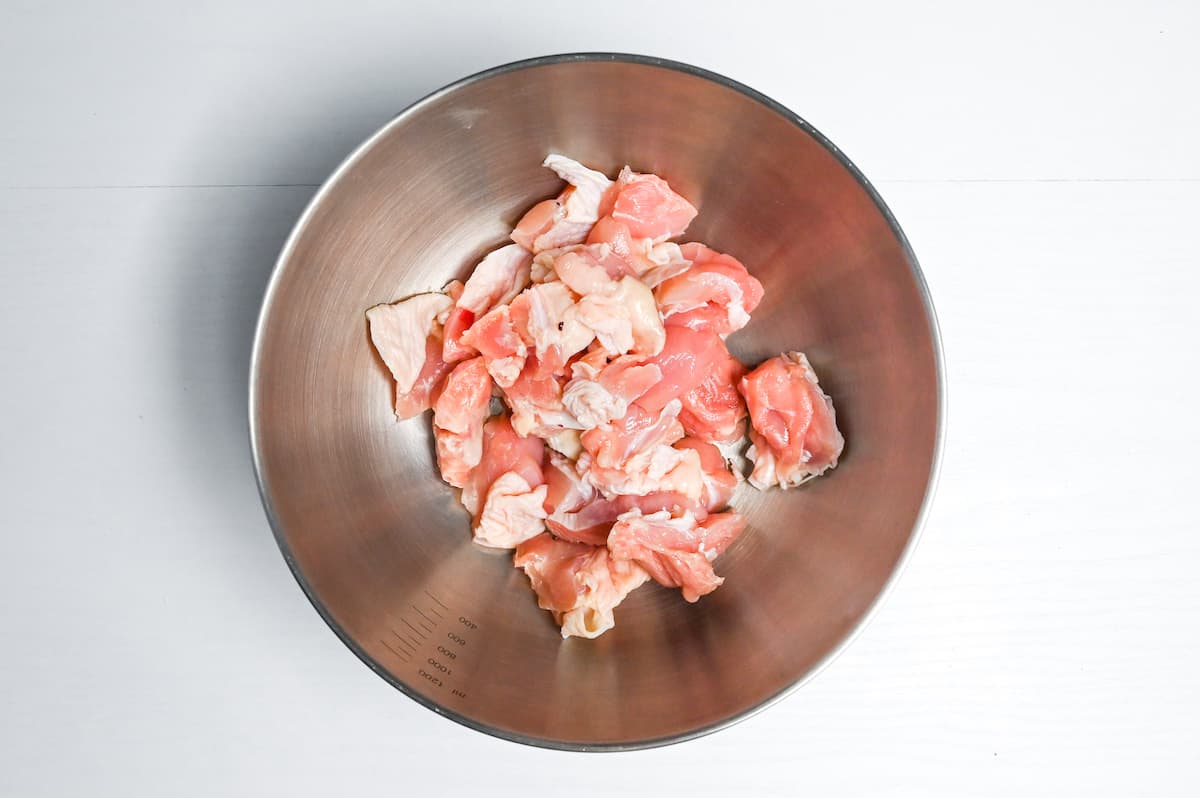
Thinly slice the aburaage (twice-fried tofu) and cut leeks into 5-6cm pieces (approx 2 inches).
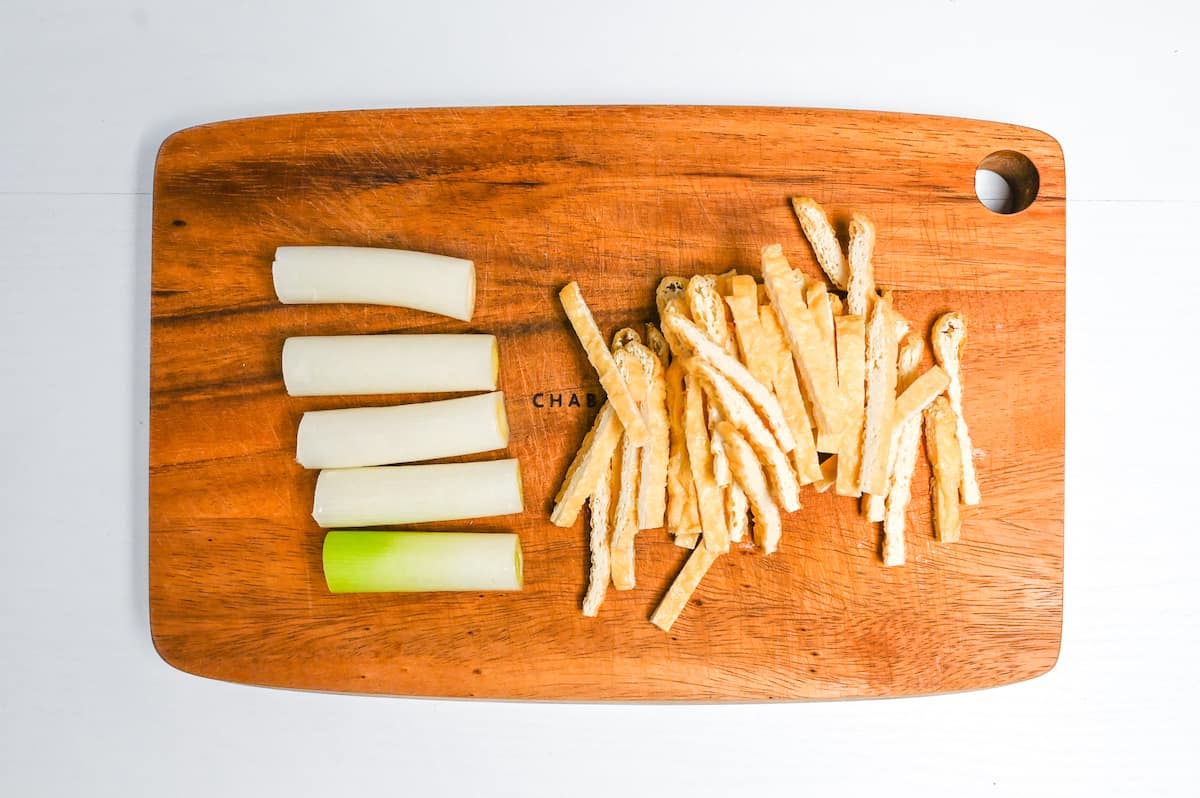
Place the bonito flakes in a small heatproof bowl and microwave for 1 minute at 500W. This will dry it out more and make the texture crumbly.

Crush the flakes with your fingers until it becomes a fine powder.

Set aside for later.
Take a large pan and heat it on medium. Once hot, add a drizzle of oil. Place the chicken with the skin side facing down and add the leeks.
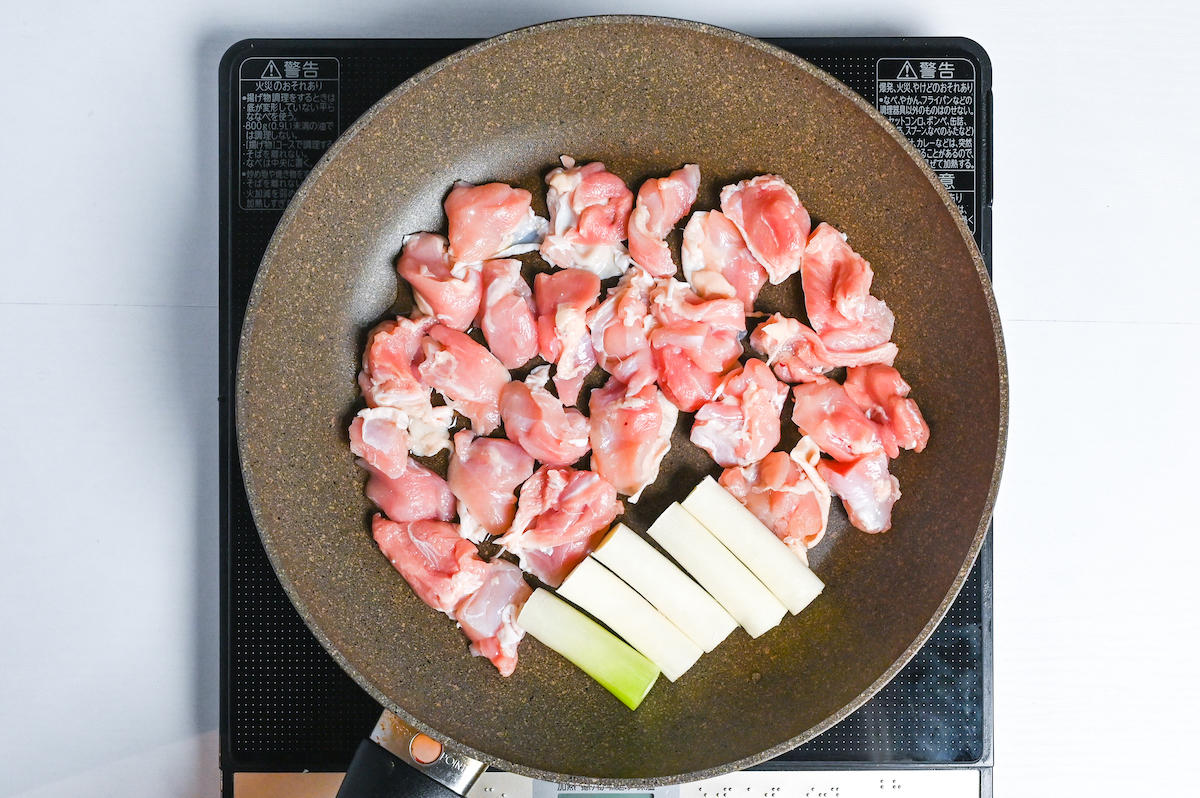
Once the chicken is golden, turn over and cook on the other side. Rotate the leeks from time to time to brown the surface evenly.
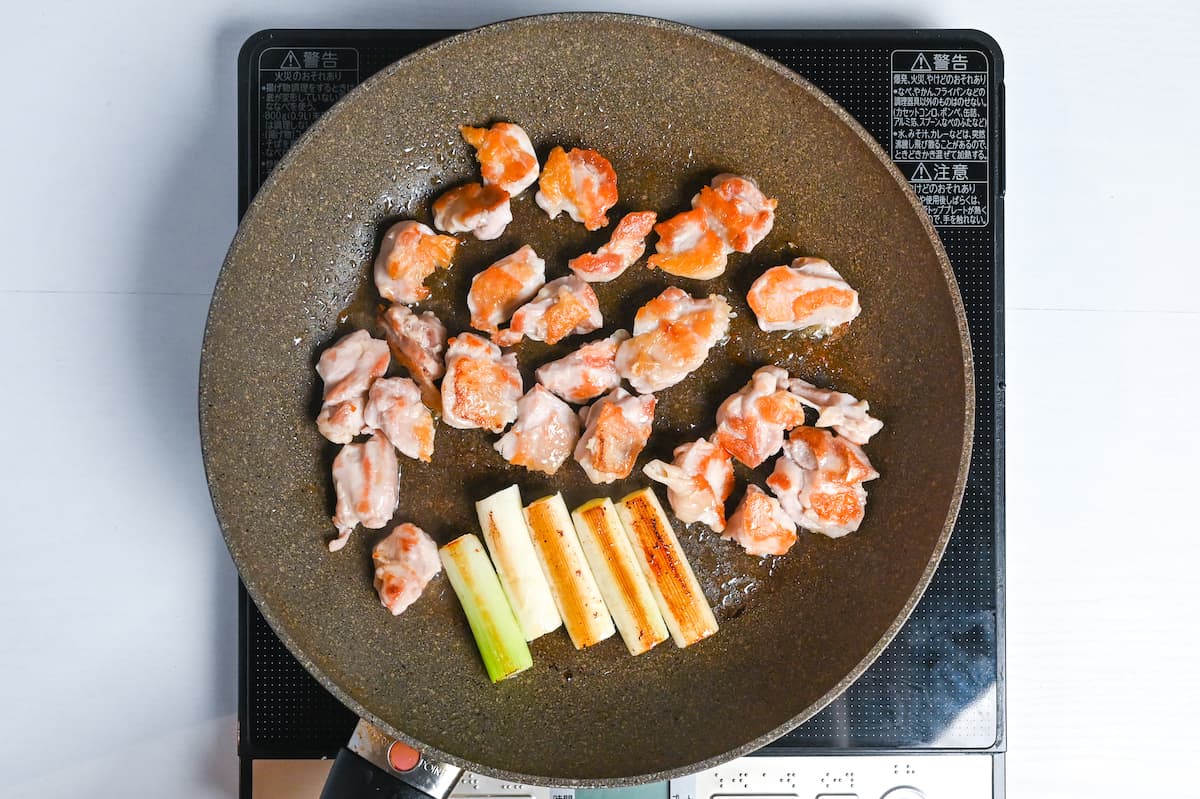
Once the chicken is cooked through, pour the dashi into the pan and bring to a boil. When it starts to boil, turn the heat down to a simmer.
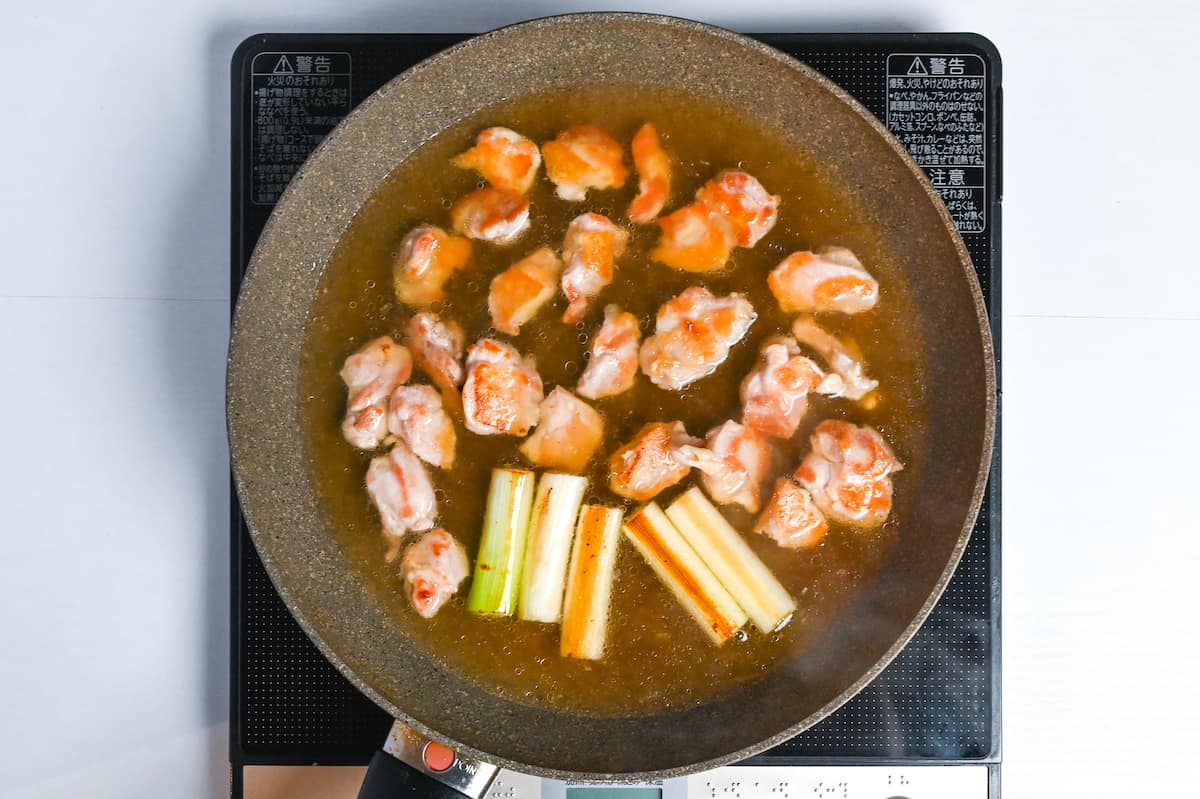
Season the soup with chicken stock powder, light soy sauce, sake, mirin and salt. Mix and then add the abuurage and bonito flake powder.
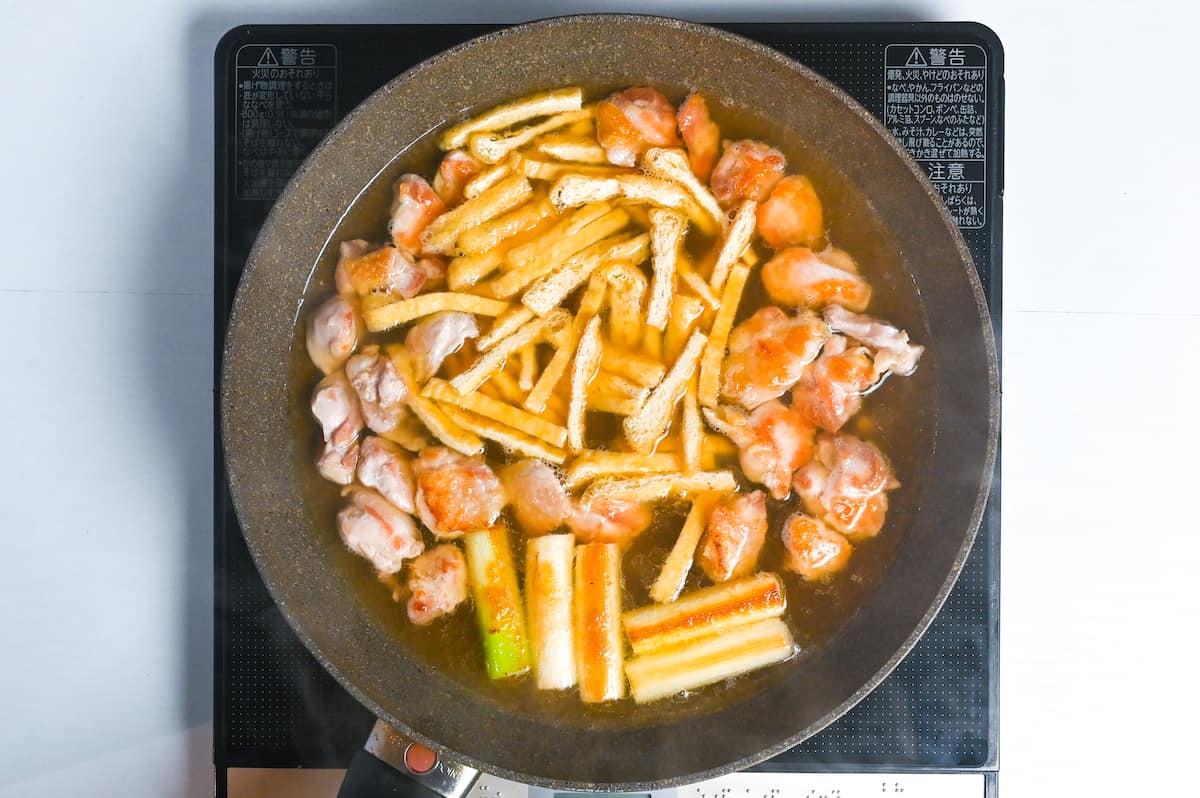
Simmer for a few minutes to warm the tofu through.
Make a weak slurry by mixing 1 tbsp of cold water with 1 tsp of potato starch. Pour the slurry into the pan and heat for 1-2 minutes or until the soup is slightly thickened.
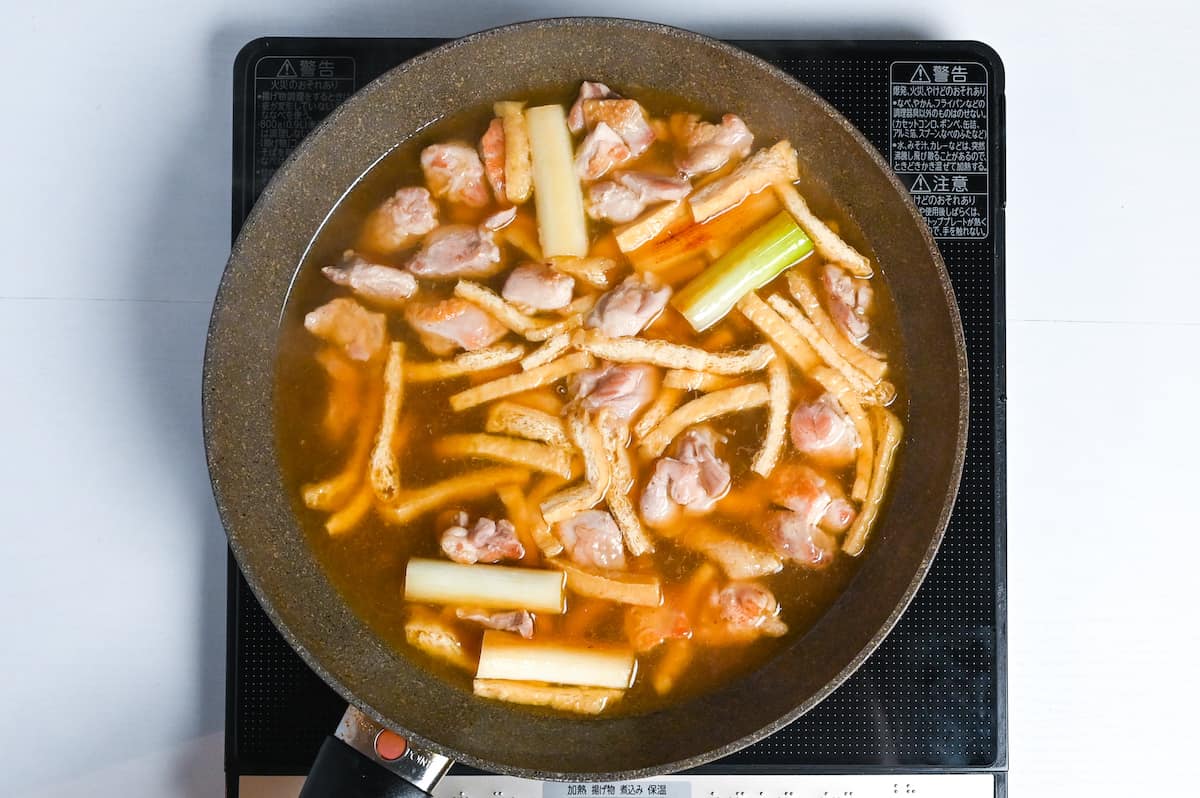
Be careful not to cook for too long or let the soup become too thick.
Place cooked udon noodles into serving bowls and divide the soup, chicken, tofu and spring onion into each bowl.
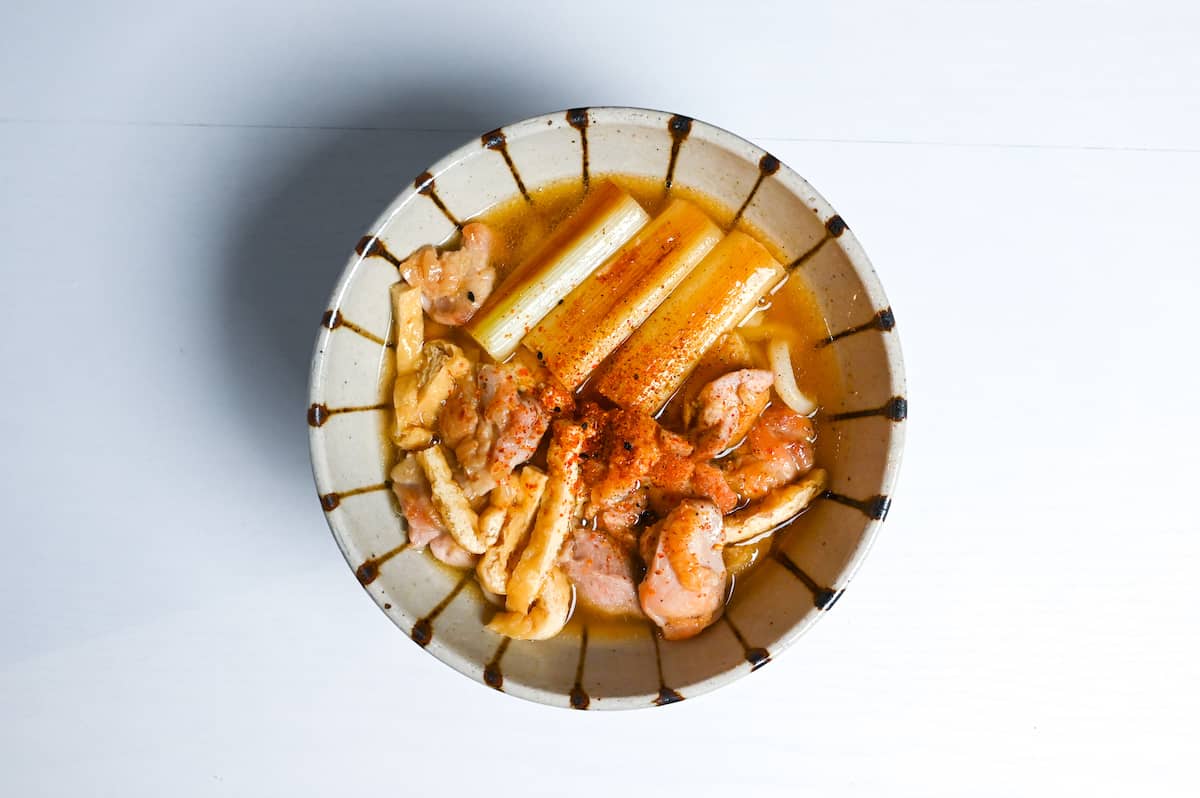
Sprinkle with shichimi togarashi (Japanese chili pepper) and enjoy!
Jump to Full Recipe Measurements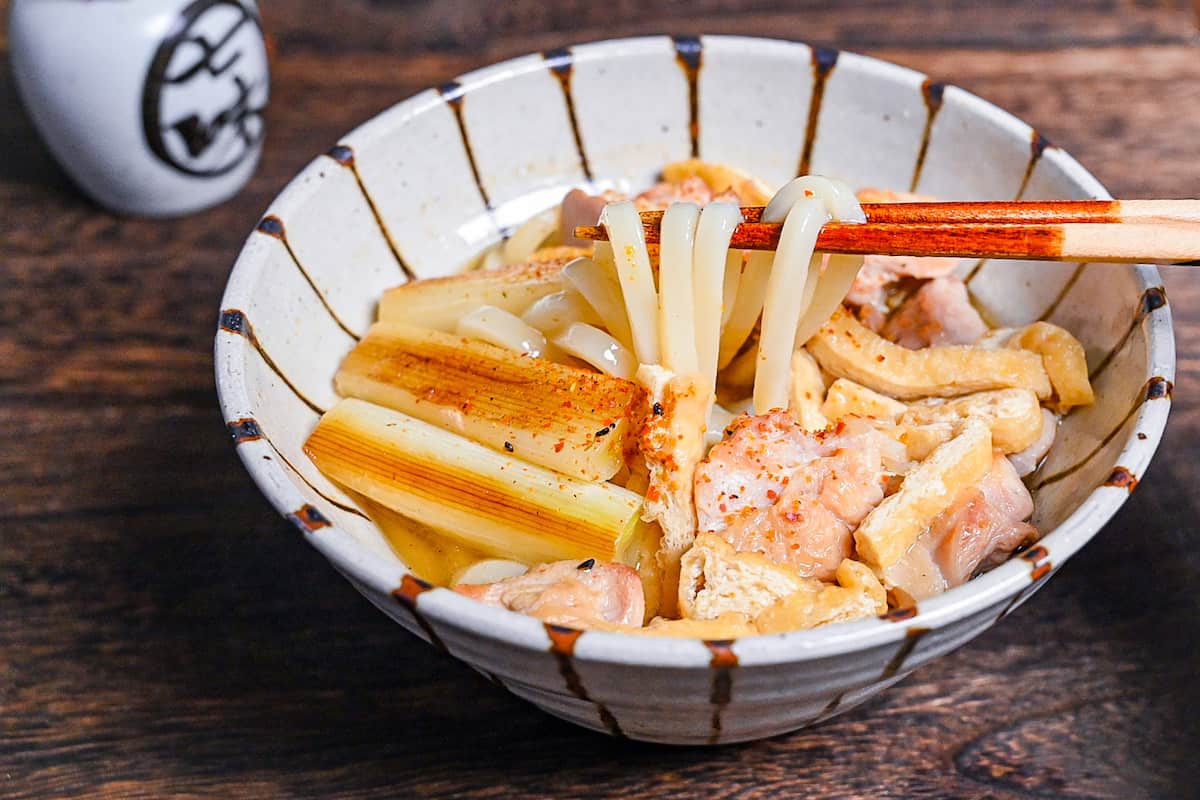
I hope you enjoy this Chicken Udon recipe! If you try it out, I’d really appreciate it if you could spare a moment to let me know what you thought by giving a review and star rating in the comments below. It’s also helpful to share any adjustments you made to the recipe with our other readers. Thank you!
More Japanese Udon Recipes
- Pork Udon Noodle Soup (Butaniku Udon)
- Beef Udon Noodle Soup (Niku Udon)
- Oyako Udon (Chicken and Egg Udon Noodle Soup)
- Shrimp Tempura Udon Noodle Soup (Ebiten Udon)
Want more inspiration? Explore my Udon Roundup Post for a carefully selected collection of tasty udon recipe ideas to spark your next meal!
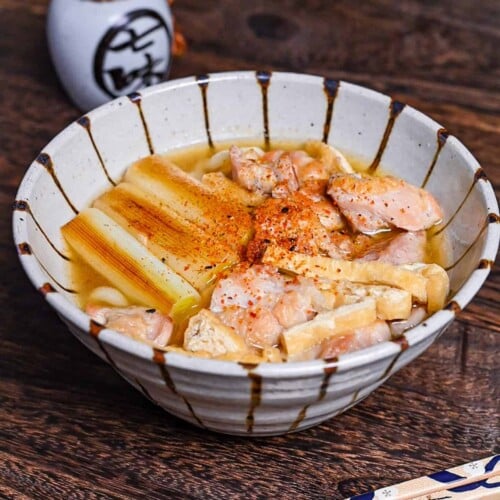
Chicken Udon Noodle Soup (Tori Nanban Udon)
Ingredients
- 250 g boneless chicken thigh boneless, skin-on, cut into bitesize pieces
- 100 g Japanese leeks (naganegi) or regular leeks, cut into 5cm pieces (2 inch)
- 2 sheets fried tofu pouch (aburaage) (aburaage)
- 1 tbsp bonito flakes (katsuobushi)
- 1 tsp cooking oil neutral flavored
- 400 ml dashi stock
- 1 tsp Chinese-style chicken bouillon powder (granules)
- 1 tbsp light soy sauce
- 1 tbsp sake
- 1 tbsp mirin
- ⅛ tsp salt
- 1 tbsp water to make slurry
- 1 tsp potato starch to make slurry
- 2 portions cooked udon noodles
- 2 pinches Japanese chili powder (shichimi togarashi) (shichimi togarashi)
Instructions
- Sprinkle 1 tbsp bonito flakes into a heatproof bowl and microwave for 1 minute at 500W. Crush the flakes with your fingers to make a fine powder.

- Cut the 100 g Japanese leeks (naganegi) into 5cm (2 inches) pieces and thinly slice the 2 sheets fried tofu pouch (aburaage).

- Heat a large pan on medium and once hot, add 1 tsp cooking oil. Place 250 g boneless chicken thigh pieces with the skin side down and add the 100 g Japanese leeks (naganegi).

- Once the chicken is golden, turn it over and brown it on the other side. Turn the spring onion from time to time to char the surface evenly.

- Once the chicken is cooked through, add 400 ml dashi stock and bring to a boil. When it starts to boil, turn the heat down to a simmer and add 1 tsp Chinese-style chicken bouillon powder (granules), 1 tbsp light soy sauce, 1 tbsp sake, 1 tbsp mirin and ⅛ tsp salt.

- Mix well and then add the 2 sheets fried tofu pouch (aburaage) and katsuobushi powder from earlier.

- Simmer for a few minutes and then add the slurry (1 tbsp water mixed with 1 tsp potato starch). Continue to simmer for 1-2 minutes or until the soup is slightly thickened. (Be careful not to overcook or let the broth become too thick).

- Place the 2 portions cooked udon noodles in serving bowls and equally divide the soup and toppings. Sprinkle with 2 pinches Japanese chili powder (shichimi togarashi) and enjoy!

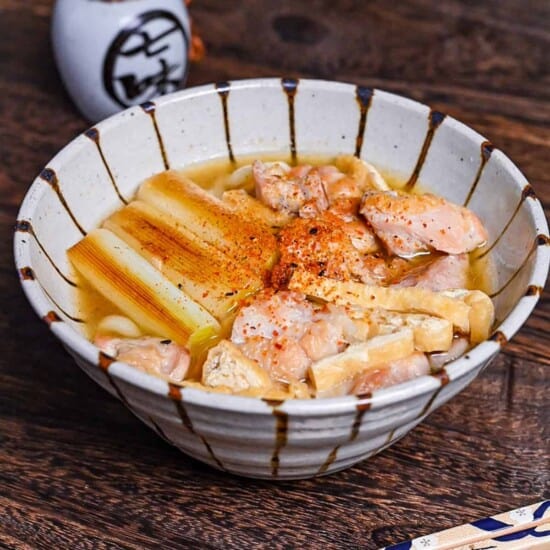


Leave a rating and a comment